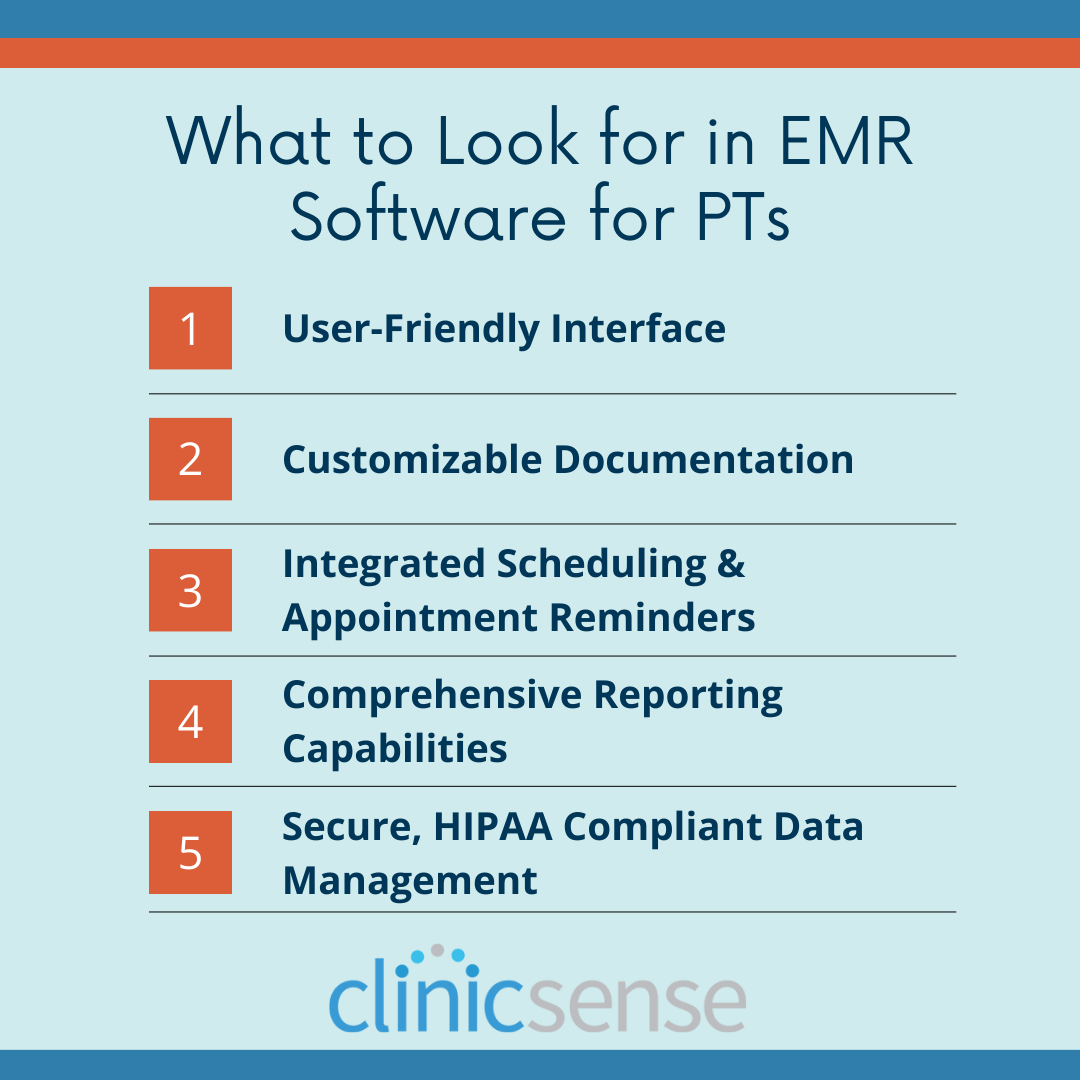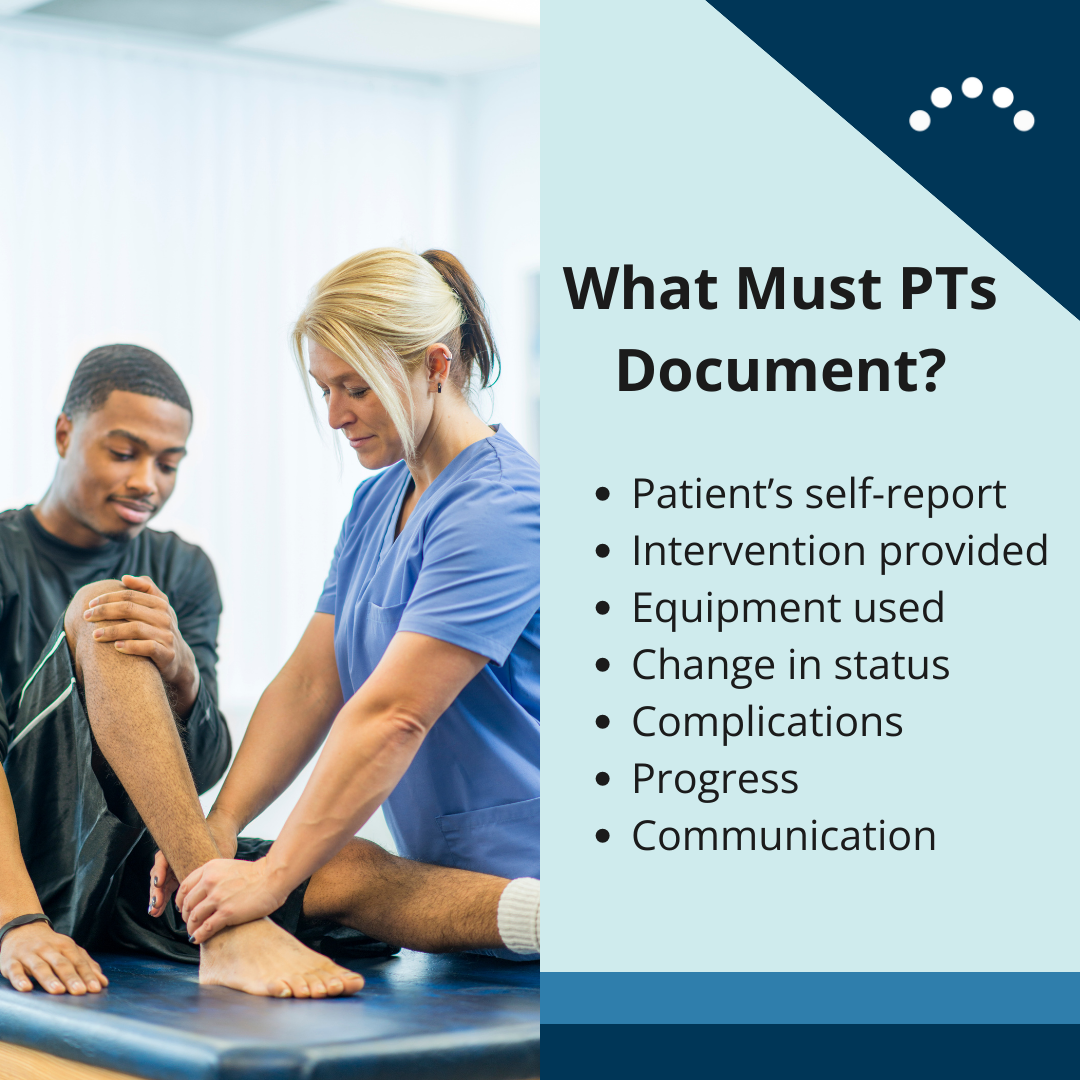Physical Therapy Business Tips
February 7, 2024

Electronic Medical Records (EMR) Software is crucial for physical therapists (PTs) to manage their practices effectively. This software streamlines patient care and administrative tasks, making it a key component in the successful operation of a PT clinic.
As a PT, whether you're establishing a new practice or enhancing an existing one, the right EMR software can revolutionize your workflow. This article is designed to guide you in selecting the most effective EMR and documentation software for your practice.
In this article, you will learn:
Selecting the right software is a significant step towards optimizing your practice's efficiency and patient care. Let's dive into the essential features that make an EMR system a valuable asset for your PT clinic.
Physical therapists need specialized software to run their practice efficiently, including both Electronic Medical Records (EMR) and Electronic Health Records (EHR) systems. These tools streamline patient documentation, manage appointments, and ensure secure data handling, catering to the unique needs of their practice.
Whether you're just starting a physical therapy practice or stepping up your game and expanding your PT business, you’ll need the right software to make everything flow smoothly.
In physical therapy, Electronic Medical Records (EMR) are digital versions of patients' health information, specifically focusing on treatment records. EMRs enable therapists to track patient progress over time, manage treatment plans, and ensure continuity of care within their practice.
EHR (Electronic Health Records) and EMR (Electronic Medical Records) differ primarily in scope. EMRs are digital records focused on a single practice's clinical data. In contrast, EHRs encompass a broader view, integrating health information across multiple healthcare settings for comprehensive patient care.
For more information on different types of software available to healthcare providers, check out the article Practice Management Software Vs EHR & EMR Systems Explained.
If you’re shopping around for EMR software for your physical therapy practice, you should look for the following features to ensure ease of use, streamlined workflow, and productivity:

Time is a precious commodity in physical therapy, where efficient management often dictates success. That's where a user-friendly interface in PT EMR and EHR systems becomes a game-changer. Imagine software that's as intuitive as your favorite smartphone app, guiding you smoothly through patient records, scheduling, and documentation.
For cash-based practices and out-of-network providers, this ease of use isn't just a convenience; it's crucial. These professionals often juggle multiple roles, from therapists to administrators. A straightforward, well-designed interface reduces the learning curve, allowing them to spend more time with patients and less on navigating complex software.
Key features to look for include a clean layout, simple navigation menus, and quick access to frequently used functions. The ability to customize views and templates to fit your specific workflow can also significantly enhance efficiency. Remember, in a field where personal touch and time management are paramount, a user-friendly interface isn't just a tool—it's your partner in delivering exceptional care
Customizable documentation, especially in the form of SOAP notes and intake forms, is a vital tool for physical therapists. It allows for a high degree of personalization in patient records, ensuring that each treatment and assessment is accurately documented according to the specific needs of the patient. Custom templates for SOAP notes are particularly valuable, enabling therapists to efficiently track progress and tailor their treatment plans to each individual's requirements.
The customization also extends to intake forms, crucial for gathering essential patient history and current health concerns. By adapting these forms to suit the specific needs of their practice, therapists can ensure they are capturing the most relevant and useful information from the outset. This level of detailed and tailored documentation not only improves the quality of patient care but also optimizes administrative efficiency. With more time saved from paperwork, therapists can focus more on direct patient care, enhancing the overall effectiveness and success of their practice.
PT documentation is the detailed recording of a patient's clinical data, treatment plans, progress notes, and outcomes in physical therapy. It encompasses everything from initial evaluations to discharge summaries, ensuring continuity of care and effective communication among healthcare providers.

Integrated scheduling and appointment reminders are vital for efficiently managing a physical therapy practice. This feature allows therapists to streamline appointment booking, directly linking each appointment to the patient's record for seamless management. Automated reminders reduce no-shows, sending timely notifications via email or text to ensure patients remember their appointments.
This integration not only simplifies administrative tasks but also enhances patient care. By maintaining a steady flow of visits and minimizing scheduling conflicts, therapists can focus more on treatment and less on administrative logistics. Ultimately, this integration is essential for optimizing both the patient experience and the practice's operational efficiency.
Comprehensive reporting capabilities in PT EMR and documentation software are essential for tracking and improving both patient care and practice management. These tools enable therapists to generate detailed reports on patient outcomes, treatment effectiveness, and financial performance. This data-driven insight helps in fine-tuning treatment approaches and making informed business decisions.
Furthermore, such reporting is invaluable for monitoring key performance indicators like patient visits and revenue, assisting in strategic planning and resource allocation. Ultimately, these capabilities are not just a feature, but a fundamental aspect of maintaining high standards of care and ensuring the growth and efficiency of the practice.
Secure data management is essential for physical therapy practices, particularly in adhering to HIPAA standards in the United States and PIPEDA regulations in Canada. These laws mandate the protection of patient information, requiring practices to implement robust security protocols. For PT EMR and documentation software, this means ensuring all patient data is stored, accessed, and shared with the highest level of confidentiality and security.
By choosing software that meets these stringent compliance standards, practices safeguard against unauthorized access and breaches, protecting both their patients and their operations. This commitment to security not only fulfills legal obligations but also strengthens patient trust, as they know their sensitive health information is managed with utmost care.
For independent PTs and physical therapy clinics seeking a top-tier EMR solution, ClinicSense is a standout option. It effectively consolidates the essential features a modern practice needs. ClinicSense offers an intuitive platform for managing patient information and streamlines key tasks with its integrated scheduling system. Its customizable approach to documentation, including versatile SOAP notes, adapts effortlessly to various treatment requirements.
ClinicSense also excels in data analysis, providing clinics with actionable insights through its robust reporting tools. Moreover, its commitment to data security is evident, fully compliant with HIPAA and PIPEDA standards, ensuring patient information is always protected. This combination of efficiency, customization, and security makes ClinicSense a prime choice for those aiming to optimize their physical therapy practice.



For 14 Days